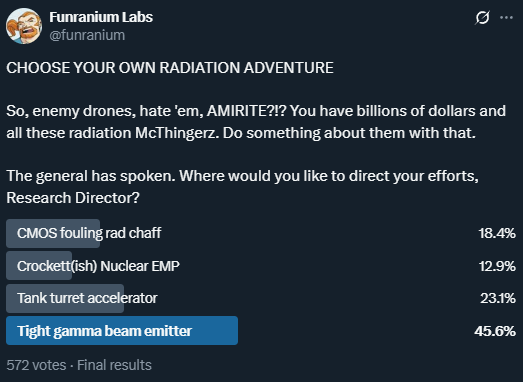I’m very proud of all of you for identifying that these are all TERRIBLE IDEAS. The thing about terrible ideas is that they still occur to people. Sometimes staggering amounts of money will be spent to try to make them real and marginally less terrible.
[The twenty sixth in an ongoing series of my compiled explainers for my CHOOSE YOUR OWN RADIATION ADVENTURE quizzes. There’s never really a right answer but some might work out better under the constraints of the scenario. It’s like poetry, really.]

But that is another story.
But as long as we’re mentioning Mr. Air Force himself, let’s talk about chaff. Traditionally, you use it to foul radar but it’s less useful against the CMOS camera systems of modern drones, though they may have radar as well. Since enough people have sent videos of it happening to me over the years, here’s hoping you’re familiar with the oversaturation of CMOS detectors you can get with exposure to ionizing radiation. It’s very similar to overexposing film, in how it disturbs or ruins images. If you could deliver enough airborne radioactive material as “chaff” to the vicinity of the drone, that was also spicy enough to mess with the CMOS, that’s a legit method. Of course, there is the teensy tiny problem of what happens to chaff afterwards. When tiny bits of aluminum, mylar, or glass rain out of the sky, it’s pollution but only at a nuisance level. When your airborne radiological dispersal device rains out of the sky, congratulations, you’ve just made a large scale contamination event. Curtis LeMay’s strategic bombing doctrine looks kind in retrospect. You’ll win the skies but lose the ground below.
Maybe a more localized scope is in order rather than theater denial weapons. What if I could fry the drone’s CMOS and electronics from the ground instead? So, an accelerator mounted in a tank turret or a highly collimated gamma beam amount to the same thing from the perspective of a drone in the sky. There are some very different concerns on the ground. As I said in my hint, photons are indistinguishable to the observer other than by their energy; 1MeV is 1MeV, doesn’t matter where it came from. But, as a matter of definition, we say gamma rays come from nuclear reactions whereas x-rays come from electron shells. Which means for your highly collimated gamma beam, you’re gonna need a LARGE source of very energetic gamma. Radioactive materials annoyingly emit radiation in all direction uniformly, but you only need the tiny pencil beam you’re aiming at the drone.
Also, aiming is non-trivial.
[listens to earpiece] I’m told that this might not work.
You’ll want a synchrotron emitter to give a high energy x-ray that’s indistinguishable from gamma rays, because otherwise you’re firing accelerated charged particles directly into the sky and they behave differently. Well, not that differently. You get scattering no matter what. Also, depending on what you’re accelerating and how much oomph you’re putting into it, you will slowly make your tank radioactive through activation. Also, you may have noticed that we tend to put accelerators in large shielded facilities. Your tank will not be one of those. Incidentally, this is why the Particle Projection Cannons (PPCs) in Battletech have always seemed very silly to me because they’re just ‘mech mounted accelerators.
All of this is to say, bless their hearts, General Atomics has never met a request for proposals that’s too daring to turn down. Even if one military branch says no out of it, there’s several more to talk to.
~fin~
